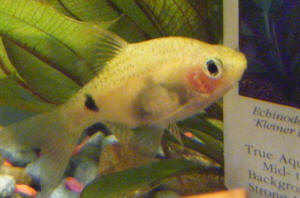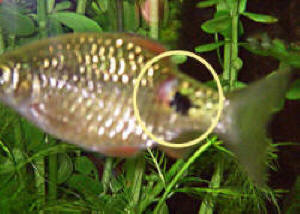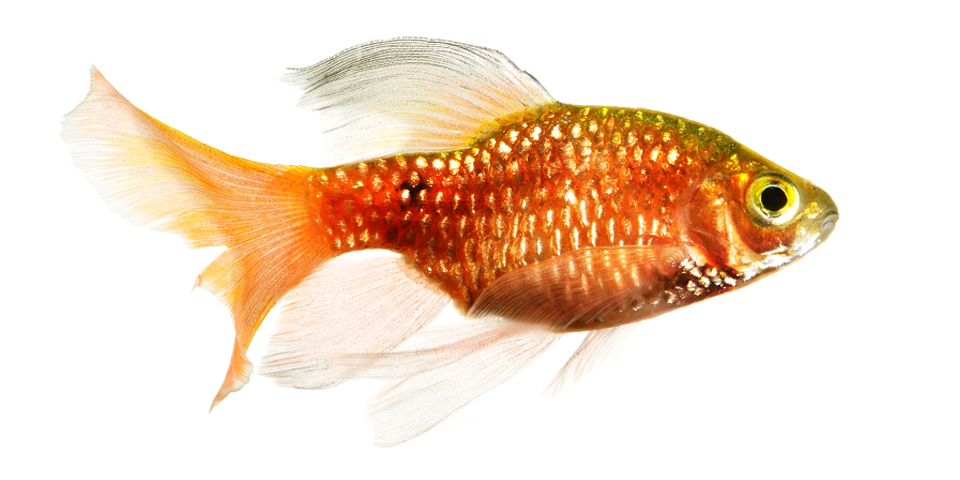Rosy Barbs may experience health issues like Ich and Fin Rot. These conditions are often caused by poor water quality.
Rosy Barbs are popular freshwater fish known for their vibrant colors and active nature. They thrive in well-maintained aquariums and require specific water conditions to stay healthy. Common health problems in Rosy Barbs include Ich and Fin Rot, both of which can be prevented with proper care.
Ich, also known as white spot disease, is a parasitic infection that manifests as white spots on the fish’s body. Fin Rot, on the other hand, is a bacterial infection that deteriorates the fish’s fins. Keeping the tank clean, maintaining stable water parameters, and providing a balanced diet are crucial for preventing these diseases. Regular monitoring and prompt treatment can ensure your Rosy Barbs remain healthy and vibrant.
Introduction To Rosy Barb Health
Rosy Barbs are vibrant, lively fish. They need special care to stay healthy. Understanding their health is key to their well-being. This guide will help you learn more about their health problems.
Basic Care Tips
Proper care keeps your Rosy Barb happy and healthy. Here are some essential tips:
- Clean Water: Change 25% of the water weekly.
- Right Temperature: Maintain water temperature between 64-72°F (18-22°C).
- Balanced Diet: Feed them a mix of flakes, pellets, and live food.
- Tank Size: Provide at least a 20-gallon tank for a small group.
- Tank Mates: Choose peaceful, compatible fish.
Importance Of Regular Check-ups
Regular check-ups are crucial for spotting health issues early. Here’s why:
- Early Detection: Find problems before they become serious.
- Prevent Diseases: Keep your fish free from infections and parasites.
- Monitor Growth: Ensure your fish are growing properly.
- Water Quality: Regular tests keep water conditions optimal.
| Check-up Frequency | Task |
|---|---|
| Weekly | Water change and quality test |
| Monthly | Inspect fish for signs of disease |
| Quarterly | Deep clean tank and equipment |
Identifying Common Health Problems
Understanding the health of your Rosy Barb is crucial. Knowing the signs of illness early can save their lives. This section will help you identify common health problems in Rosy Barbs.
Signs Of Illness
Look for these signs of illness in your Rosy Barb:
- Faded or dull colors
- Clamped fins
- White spots on the body
- Red streaks on fins
- Swollen abdomen
If you see any of these signs, your fish may be sick. Quick action is needed to address these issues.
Behavioral Changes
Behavioral changes often indicate health problems. Watch for:
- Loss of appetite
- Sluggish swimming
- Hiding more than usual
- Gasping at the surface
- Scratching against objects
These behaviors can signal stress or disease. Addressing these changes early can help improve their health.
| Symptom | Possible Health Issue |
|---|---|
| White spots | Ich |
| Red streaks | Bacterial infection |
| Swollen abdomen | Dropsy |
| Loss of appetite | Parasites |
Keep an eye on your Rosy Barb. Early detection of health issues is key to their wellbeing.
Ichthyophthirius (ich) In Rosy Barbs
Ichthyophthirius, commonly known as Ich, is a parasitic disease. This disease affects many freshwater fish, including Rosy Barbs. Ich is caused by a protozoan parasite, Ichthyophthirius multifiliis. It is often called “white spot disease” due to its visible symptoms on fish.
Symptoms Of Ich
Recognizing the symptoms of Ich is crucial for early treatment. Here are the common signs:
- White spots on the body and fins
- Fish rubbing against objects
- Labored breathing
- Loss of appetite
- Clamped fins
Treatment Options
Treating Ich in Rosy Barbs requires a multi-step approach. Here are effective treatment methods:
| Method | Description |
|---|---|
| Temperature Increase | Raise the water temperature to 86°F (30°C) for 3 days. |
| Salt Treatment | Add aquarium salt at 1 tablespoon per 5 gallons. |
| Medications | Use anti-parasitic medications like malachite green or formalin. |
| Quarantine | Isolate infected fish to prevent spreading. |
Always follow the instructions on medication packaging. Consistency in treatment is key to curing Ich.
Fin Rot Issues
Fin Rot is a common disease that affects Rosy Barbs. It can cause significant damage to their fins and overall health. Understanding the causes, prevention, and treatment of Fin Rot is essential for keeping your Rosy Barbs healthy and happy.
Causes Of Fin Rot
Fin Rot in Rosy Barbs is usually caused by bacterial or fungal infections. Poor water quality, stress, and injuries can also contribute to the development of Fin Rot. Here are some common causes:
- Poor Water Quality: High levels of ammonia, nitrites, or nitrates can damage the fins.
- Stress: Overcrowding, sudden temperature changes, and aggressive tank mates can stress the fish.
- Injuries: Sharp decorations or fights can injure the fins, making them susceptible to infections.
Prevention And Treatment
Preventing Fin Rot involves maintaining a clean and stress-free environment for your Rosy Barbs. Here are some effective prevention tips:
- Regular Water Changes: Change 25% of the water weekly to keep it clean.
- Maintain Proper Filtration: Use a good filter to remove waste and toxins.
- Avoid Overcrowding: Provide enough space for each fish to reduce stress.
- Monitor Water Parameters: Keep pH, ammonia, nitrites, and nitrates in check.
If your Rosy Barb develops Fin Rot, prompt treatment is necessary. Here’s how you can treat it:
- Quarantine the Affected Fish: Isolate the fish in a separate tank.
- Improve Water Quality: Ensure the quarantine tank has pristine water conditions.
- Medicate the Water: Use antibacterial or antifungal medications as recommended.
- Monitor the Fish: Keep an eye on their recovery and adjust treatments if needed.
| Action | Details |
|---|---|
| Water Change | Change 25% of water weekly |
| Filtration | Use a good filter system |
| Quarantine | Isolate sick fish |
| Medication | Use antibacterial or antifungal meds |
By following these steps, you can effectively prevent and treat Fin Rot in your Rosy Barbs, ensuring they remain healthy and vibrant.
Swim Bladder Disorders
Swim bladder disorders are common in Rosy Barbs. These issues affect their buoyancy. The swim bladder is a gas-filled organ. It helps the fish maintain its position in the water. If this organ malfunctions, it causes buoyancy problems. Understanding the symptoms and corrective measures is crucial for fish health.
Symptoms Of Swim Bladder Issues
Watch for these symptoms in your Rosy Barb:
- Fish floats upside down.
- Fish sinks to the bottom.
- Fish swims sideways.
- Struggles to maintain balance.
- Swollen belly.
If you notice these symptoms, your fish likely has swim bladder issues. Early detection is key to effective treatment.
Corrective Measures
Here are some corrective measures to help your fish:
- Improve Water Quality: Ensure clean water. Perform regular water changes.
- Adjust Feeding: Feed high-fiber foods. Avoid overfeeding.
- Isolate Affected Fish: Use a separate tank for treatment.
- Use Peas: Feed shelled peas. They help clear digestive blockages.
- Monitor Temperature: Keep the water temperature stable.
Implement these measures to help your Rosy Barb recover. Consistent care ensures long-term health for your fish.

Credit: www.reddit.com
Parasitic Infections
Rosy Barbs are beautiful fish that can suffer from parasitic infections. These infections can cause various health problems and stress in the fish. It’s important to know the common parasites and effective treatments to keep your Rosy Barbs healthy.
Common Parasites
Several parasites can infect Rosy Barbs. Here are the most common ones:
- Ichthyophthirius multifiliis (Ich): This parasite causes white spots on the fish’s body.
- Costia: These tiny parasites can irritate the fish’s skin and gills.
- Gill Flukes: These worms attach to the gills, making breathing difficult.
- Anchor Worms: These parasites burrow into the fish’s skin, causing redness and swelling.
Effective Treatments
Treating parasitic infections in Rosy Barbs requires specific methods. Here are some effective treatments:
- Quarantine: Isolate the infected fish in a separate tank.
- Medications: Use anti-parasitic medications like malachite green or formalin.
- Salt Baths: Give the fish a salt bath to remove external parasites.
- Temperature Adjustment: Increase the water temperature to speed up the parasite’s life cycle.
For easy reference, here’s a table summarizing the common parasites and their treatments:
| Parasite | Symptoms | Treatment |
|---|---|---|
| Ich | White spots on body | Medications, Temperature Adjustment |
| Costia | Skin and gill irritation | Medications, Salt Baths |
| Gill Flukes | Breathing difficulty | Medications, Quarantine |
| Anchor Worms | Redness, swelling | Medications, Quarantine |
Nutritional Deficiencies
Rosy Barbs, like all fish, need a balanced diet to stay healthy. Without essential nutrients, they can suffer from various health problems. Ensuring they get the right nutrients is crucial for their overall well-being.
Essential Nutrients
Rosy Barbs need a mix of proteins, fats, and vitamins. These nutrients help them grow, reproduce, and stay active. Without them, they can become weak and sick.
- Proteins: Help in growth and repair of tissues.
- Fats: Provide energy and support cell function.
- Vitamins: Boost the immune system and prevent diseases.
Dietary Solutions
A varied diet can prevent nutritional deficiencies. Here are some dietary solutions for your Rosy Barbs:
| Food Type | Benefits |
|---|---|
| Flake Food | Contains a balanced mix of nutrients. |
| Live Food | Rich in proteins and fats. |
| Vegetables | Provide essential vitamins and minerals. |
Feeding them a mix of these foods can keep them healthy. Rotate their diet to ensure they get all the necessary nutrients.

Credit: www.wetwebmedia.com
Maintaining A Healthy Aquarium Environment
A healthy aquarium environment is crucial for the well-being of Rosy Barbs. Keeping their habitat clean and balanced prevents many health problems. Follow these tips to ensure your Rosy Barbs thrive.
Water Quality Management
Water quality is vital for Rosy Barbs. Regularly check and maintain water parameters. Ensure the water temperature stays between 64-72°F. Keep the pH level between 6.5 and 7.5.
- Test water regularly for ammonia, nitrite, and nitrate levels.
- Perform weekly water changes of 25-30%.
- Use a good water conditioner to remove chlorine and chloramine.
- Ensure the tank is well-aerated to maintain oxygen levels.
Tank Setup Tips
A proper tank setup helps maintain a healthy environment. Use a tank size of at least 20 gallons for Rosy Barbs.
| Tank Size | Minimum 20 gallons |
|---|---|
| Substrate | Smooth gravel or sand |
| Plants | Live plants like Java fern or Anubias |
Avoid sharp decorations to prevent injuries. Provide hiding spots using rocks or driftwood. Ensure the tank has a moderate current, as Rosy Barbs enjoy swimming against it. Use a high-quality filter to keep the water clean.
- Place the tank in a quiet, stable location.
- Avoid direct sunlight to prevent algae growth.
- Maintain a consistent light cycle of 10-12 hours daily.
Feeding Rosy Barbs a balanced diet also contributes to their health. Offer a mix of flakes, pellets, and live or frozen foods.
When To Consult A Veterinarian
Rosy Barbs are beautiful and hardy fish. But they can face health issues. Knowing when to consult a veterinarian is crucial. This ensures your fish stays healthy and happy.
Recognizing Severe Symptoms
Rosy Barbs may show signs of distress. Some symptoms can be severe. Watch out for these signs:
- Clamped Fins: Fins stay close to the body.
- Labored Breathing: Rapid gill movement.
- White Spots: Signs of Ich disease.
- Loss of Appetite: Refusing to eat.
- Visible Wounds: Open sores or red streaks.
These symptoms need a vet’s attention. Early detection can save your fish.
Finding A Qualified Vet
Not all vets treat fish. Finding a qualified vet is important. Follow these steps:
- Research Online: Look for aquatic vets in your area.
- Ask for Recommendations: Consult local fish stores.
- Check Credentials: Ensure the vet has fish care experience.
- Read Reviews: Look for positive feedback from other fish owners.
A good vet can make a big difference. Ensure your Rosy Barb gets the best care possible.

Credit: www.wetwebmedia.com
Frequently Asked Questions
How Long Do Rosy Barb Fish Live?
Rosy barb fish typically live for 5 to 7 years. Proper care and a healthy environment can extend their lifespan.
Why Is My Rosy Barb Swimming Erratically?
Your rosy barb may swim erratically due to stress, poor water quality, or disease. Check water parameters and tank conditions.
How Many Rosy Barbs Should Be Kept Together?
Keep at least 5 rosy barbs together to create a harmonious environment in the aquarium. This number allows for social interaction and reduces stress.
Are Rosy Barbs Good Community Fish?
Yes, rosy barbs are excellent community fish. They are peaceful, adaptable, and get along with many other species. Ensure a spacious tank and a school of at least five to keep them happy.
Conclusion
Maintaining a healthy environment is crucial for Rosy Barb well-being. Regular water changes and a balanced diet help prevent diseases. Observing your fish for any signs of illness ensures prompt treatment. Proper care can lead to a thriving and vibrant aquarium.
Keep these tips in mind for a happy and healthy Rosy Barb.
